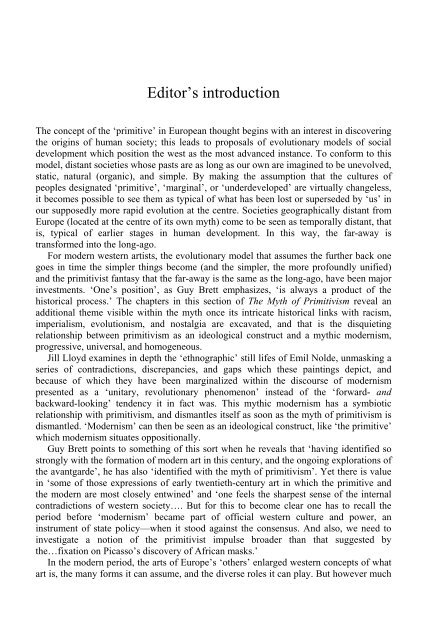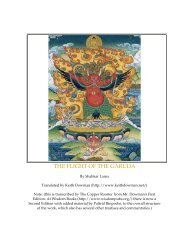Hiller - The Myth of Primitivism. Perspectives on Art - Esoteric Online
Hiller - The Myth of Primitivism. Perspectives on Art - Esoteric Online
Hiller - The Myth of Primitivism. Perspectives on Art - Esoteric Online
Create successful ePaper yourself
Turn your PDF publications into a flip-book with our unique Google optimized e-Paper software.
Editor’s introducti<strong>on</strong><br />
<str<strong>on</strong>g>The</str<strong>on</strong>g> c<strong>on</strong>cept <str<strong>on</strong>g>of</str<strong>on</strong>g> the ‘primitive’ in European thought begins with an interest in discovering<br />
the origins <str<strong>on</strong>g>of</str<strong>on</strong>g> human society; this leads to proposals <str<strong>on</strong>g>of</str<strong>on</strong>g> evoluti<strong>on</strong>ary models <str<strong>on</strong>g>of</str<strong>on</strong>g> social<br />
development which positi<strong>on</strong> the west as the most advanced instance. To c<strong>on</strong>form to this<br />
model, distant societies whose pasts are as l<strong>on</strong>g as our own are imagined to be unevolved,<br />
static, natural (organic), and simple. By making the assumpti<strong>on</strong> that the cultures <str<strong>on</strong>g>of</str<strong>on</strong>g><br />
peoples designated ‘primitive’, ‘marginal’, or ‘underdeveloped’ are virtually changeless,<br />
it becomes possible to see them as typical <str<strong>on</strong>g>of</str<strong>on</strong>g> what has been lost or superseded by ‘us’ in<br />
our supposedly more rapid evoluti<strong>on</strong> at the centre. Societies geographically distant from<br />
Europe (located at the centre <str<strong>on</strong>g>of</str<strong>on</strong>g> its own myth) come to be seen as temporally distant, that<br />
is, typical <str<strong>on</strong>g>of</str<strong>on</strong>g> earlier stages in human development. In this way, the far-away is<br />
transformed into the l<strong>on</strong>g-ago.<br />
For modern western artists, the evoluti<strong>on</strong>ary model that assumes the further back <strong>on</strong>e<br />
goes in time the simpler things become (and the simpler, the more pr<str<strong>on</strong>g>of</str<strong>on</strong>g>oundly unified)<br />
and the primitivist fantasy that the far-away is the same as the l<strong>on</strong>g-ago, have been major<br />
investments. ‘One’s positi<strong>on</strong>’, as Guy Brett emphasizes, ‘is always a product <str<strong>on</strong>g>of</str<strong>on</strong>g> the<br />
historical process.’ <str<strong>on</strong>g>The</str<strong>on</strong>g> chapters in this secti<strong>on</strong> <str<strong>on</strong>g>of</str<strong>on</strong>g> <str<strong>on</strong>g>The</str<strong>on</strong>g> <str<strong>on</strong>g>Myth</str<strong>on</strong>g> <str<strong>on</strong>g>of</str<strong>on</strong>g> <str<strong>on</strong>g>Primitivism</str<strong>on</strong>g> reveal an<br />
additi<strong>on</strong>al theme visible within the myth <strong>on</strong>ce its intricate historical links with racism,<br />
imperialism, evoluti<strong>on</strong>ism, and nostalgia are excavated, and that is the disquieting<br />
relati<strong>on</strong>ship between primitivism as an ideological c<strong>on</strong>struct and a mythic modernism,<br />
progressive, universal, and homogeneous.<br />
Jill Lloyd examines in depth the ‘ethnographic’ still lifes <str<strong>on</strong>g>of</str<strong>on</strong>g> Emil Nolde, unmasking a<br />
series <str<strong>on</strong>g>of</str<strong>on</strong>g> c<strong>on</strong>tradicti<strong>on</strong>s, discrepancies, and gaps which these paintings depict, and<br />
because <str<strong>on</strong>g>of</str<strong>on</strong>g> which they have been marginalized within the discourse <str<strong>on</strong>g>of</str<strong>on</strong>g> modernism<br />
presented as a ‘unitary, revoluti<strong>on</strong>ary phenomen<strong>on</strong>’ instead <str<strong>on</strong>g>of</str<strong>on</strong>g> the ‘forward- and<br />
backward-looking’ tendency it in fact was. This mythic modernism has a symbiotic<br />
relati<strong>on</strong>ship with primitivism, and dismantles itself as so<strong>on</strong> as the myth <str<strong>on</strong>g>of</str<strong>on</strong>g> primitivism is<br />
dismantled. ‘Modernism’ can then be seen as an ideological c<strong>on</strong>struct, like ‘the primitive’<br />
which modernism situates oppositi<strong>on</strong>ally.<br />
Guy Brett points to something <str<strong>on</strong>g>of</str<strong>on</strong>g> this sort when he reveals that ‘having identified so<br />
str<strong>on</strong>gly with the formati<strong>on</strong> <str<strong>on</strong>g>of</str<strong>on</strong>g> modern art in this century, and the <strong>on</strong>going explorati<strong>on</strong>s <str<strong>on</strong>g>of</str<strong>on</strong>g><br />
the avantgarde’, he has also ‘identified with the myth <str<strong>on</strong>g>of</str<strong>on</strong>g> primitivism’. Yet there is value<br />
in ‘some <str<strong>on</strong>g>of</str<strong>on</strong>g> those expressi<strong>on</strong>s <str<strong>on</strong>g>of</str<strong>on</strong>g> early twentieth-century art in which the primitive and<br />
the modern are most closely entwined’ and ‘<strong>on</strong>e feels the sharpest sense <str<strong>on</strong>g>of</str<strong>on</strong>g> the internal<br />
c<strong>on</strong>tradicti<strong>on</strong>s <str<strong>on</strong>g>of</str<strong>on</strong>g> western society…. But for this to become clear <strong>on</strong>e has to recall the<br />
period before ‘modernism’ became part <str<strong>on</strong>g>of</str<strong>on</strong>g> <str<strong>on</strong>g>of</str<strong>on</strong>g>ficial western culture and power, an<br />
instrument <str<strong>on</strong>g>of</str<strong>on</strong>g> state policy—when it stood against the c<strong>on</strong>sensus. And also, we need to<br />
investigate a noti<strong>on</strong> <str<strong>on</strong>g>of</str<strong>on</strong>g> the primitivist impulse broader than that suggested by<br />
the…fixati<strong>on</strong> <strong>on</strong> Picasso’s discovery <str<strong>on</strong>g>of</str<strong>on</strong>g> African masks.’<br />
In the modern period, the arts <str<strong>on</strong>g>of</str<strong>on</strong>g> Europe’s ‘others’ enlarged western c<strong>on</strong>cepts <str<strong>on</strong>g>of</str<strong>on</strong>g> what<br />
art is, the many forms it can assume, and the diverse roles it can play. But however much




